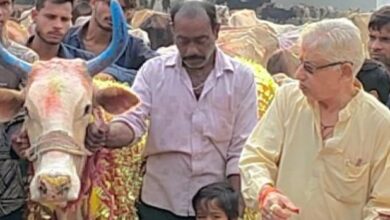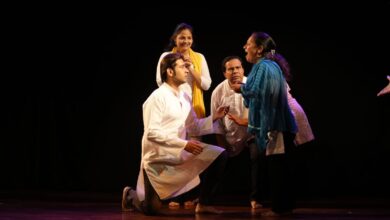The Heart of India – Where Culture, History, and Development Meets
Rising as “The Heart of India” in the Era of Nation-Building (Special Feature – Madhya Pradesh Foundation Day) By Journalist Syed Asim Ali The Journey from Reorganization to Becoming the “Heart”


When the train leaves Bhopal and winds its way through the lush Satpura hills toward Bilaspur, every passing scene seems to echo with the heartbeat of India’s heartland. Through the window, you glimpse golden mustard fields swaying in rhythm, and dense sal and teak forests casting their cool shadows. This is a land where nature, culture, and history merge into a melodious harmonyThe intricate sculptures of Khajuraho are not merely artistic expressions—they narrate the story of human aesthetic sensibility. The serene stupa of Sanchi leaves an indelible mark of Buddhist compassion and meditation, while the prehistoric Bhimbetka rock shelters stand as testimony to the dawn of human civilization. In the forests of Kanha and Bandhavgarh, the roar of the tiger reminds us of nature’s untamed power, while the gentle breeze along the Narmada River reveals the life-giving soul of the region.Madhya Pradesh’s identity is shaped not merely by its geographical centrality, but by its cultural diversity, folk traditions, and deep human values. The soil here carries the rhythm of folk songs, the beats of tribal dances, and the warmth of oral tales. The state’s tribal communities have long revered nature as divine, setting examples of harmonious coexistence with the environment.After Independence, the state reinvented itself multiple times. In 1956, with the reorganization of states, Madhya Bharat, Bhopal, and Vindhya Pradesh merged to form the unified state of Madhya Pradesh. Its capital, Bhopal, embraced both tradition and modernity—its tranquil lakes and graceful architecture shaping a unique urban characterBeing called the “Heart of India” is not a slogan—it reflects the depth of spirit that defines this land: simplicity of life, diversity of culture, and the steady pulse of nature. Though situated at the very center of India’s map, Madhya Pradesh plays the role of life’s circulatory system for the nation—just as the heart pumps blood throughout the body, this state nourishes India with its culture, vitality, and warmth.
Why is Madhya Pradesh Called the “Heart of India”?
The title “Heart of India” is not merely due to geography; it symbolizes Madhya Pradesh’s spiritual, cultural, and historical essence. Nestled at the core of the subcontinent, the state bridges northern and southern India, eastern and western India alike. Its soil embodies unity in diversity.
This land is filled with tales of valor, sacrifice, and resistance—from Rani Lakshmibai’s last stand in Gwalior, to Tantya Bhil’s people’s rebellion, and Tatya Tope’s indomitable courage. Alongside its heroic past, Madhya Pradesh’s confluence of art, history, and nature makes it extraordinary: Khajuraho’s artistry, Sanchi’s serenity, Kanha’s wilderness, and the Narmada’s eternal flow together shape a sacred landscape.
From Malwa’s Ger festival to Gond tribal dances, from Ujjain’s Mahakal Lok to Bhopal’s serene lakes, the soul of India breathes here. That is why Madhya Pradesh is not just the central point on the map—it is truly the heartbeat of the nation.
The Historical Journey to Modern Madhya Pradesh
1947 – After Independence: A Divided Heartland
When India achieved independence in 1947, the region we now know as Madhya Pradesh was not a single entity. It consisted of four administrative regions: Madhya Bharat, Vindhya Pradesh, Bhopal State, and Madhya Pradesh–Berar. Each had distinct cultural, linguistic, and political histories.
Madhya Bharat comprised princely states like Gwalior, Indore, and Ujjain, influenced by Maratha and Bundeli heritage.
Vindhya Pradesh encompassed Bundelkhand areas such as Rewa, Satna, and Chhatarpur.
Bhopal State, ruled by the Nawabs, was known for its Islamic architecture and refined culture.
Madhya Pradesh–Berar included Nagpur, Jabalpur, and Chhindwara—regions shaped by British administration.
Integrating these diverse lands into one cohesive identity posed a great challenge. This quest for unity ultimately led to the States Reorganization Act of 1956, which gave birth to the modern Madhya Pradesh.
1956 – The Reorganization: Birth of the “Heart of India”
The year 1956 marked a turning point in Madhya Pradesh’s history. India undertook a massive reorganization of states based on linguistic and administrative criteria. Following the States Reorganization Commission’s recommendations, Madhya Bharat, Vindhya Pradesh, and Bhopal merged to form Madhya Pradesh.
Though Nagpur and parts of Berar were transferred to Maharashtra, the new state emerged as a cultural and linguistic whole—united by Hindi and shared traditions. Initially, Jabalpur was chosen as the capital, but soon Bhopal was declared the permanent seat due to its central location and administrative advantages.
This reorganization was not just about redrawing boundaries—it marked the birth of a unified identity that would soon come to represent the “Heart of India.”
2000 – The Formation of Chhattisgarh: A New Chapter
On 1 November 2000, a new chapter unfolded when Chhattisgarh was carved out of Madhya Pradesh. This wasn’t merely an administrative move but a recognition of distinct regional aspirations and socio-cultural identity.
The tribal heartland of Chhattisgarh, rich in folk traditions and natural resources, had long sought greater representation and focused development. With the Madhya Pradesh Reorganization Act, 2000, Bhopal remained the capital of Madhya Pradesh, while Raipur became the capital of the newly formed Chhattisgarh.
Both states embarked on their own paths—Madhya Pradesh consolidated administrative and economic stability, while Chhattisgarh began shaping its own unique cultural and developmental identity.
2025 – The New Confident Madhya Pradesh: A Fusion of Growth and Heritage
Today, in 2025, Madhya Pradesh stands tall with renewed confidence. It is not only India’s geographical heart but also a symbol of balance between heritage, environment, and progress. With smart cities, growing infrastructure, and tourism expansion, the state continues to preserve its folk traditions and natural treasures. The slogan “M.P. – Ajab Hai, Ghazab Hai” is no longer just a tagline—it reflects a living identity, a land that embraces both development and soulfulness.
Heroes and Visionaries Who Shaped Its Identity
The soil of Madhya Pradesh is steeped in stories of bravery, creativity, and resilience:
Rani Lakshmibai – The immortal heroine of the 1857 revolt who fought her last battle in Gwalior.
Tatya Tope – The brilliant strategist and freedom fighter.
Tantya Bhil – Known as the “Robin Hood of India,” a tribal warrior who fought oppression.
Habib Tanvir – The legendary theatre artist from Raipur who brought folk narratives to the world stage.
Harivansh Rai Bachchan – The iconic Hindi poet whose verses reshaped modern Indian literature.
Together, they shaped the intellectual and cultural spirit of Madhya Pradesh.
The Prime Minister’s Words: “M.P. – Ajab Hai, Ghazab Hai”
When Prime Minister Narendra Modi said, “M.P. Ajab Hai, Ghazab Hai,” it wasn’t just a slogan—it captured the essence of this land.
Madhya Pradesh is a place where history and modernity coexist. From the Sanchi Stupa, echoing Emperor Ashoka’s Buddhist legacy, to the smart cities of Indore and Bhopal, this state exemplifies the union of tradition and progress.
It is “Ajab” (unique) in its diversity—where tribal, Marathi, Bundeli, and Malwi influences blend seamlessly. It is “Ghazab” (extraordinary) in its potential—with agricultural strength, industrial growth, tourism, and environmental preservation driving its progress.
The Mahakal Lok of Ujjain and the Jyotirlinga of Omkareshwar symbolize spiritual power; Indore’s cleanliness model inspires modern governance; Bhopal’s lakes and greenery reflect environmental harmony; and Kanha, Bandhavgarh, and Pench showcase India’s natural biodiversity.
The Prime Minister’s statement resonates deeply with every citizen—it’s an acknowledgment that Madhya Pradesh truly is the Heart of India, whose pulse fuels the nation’s vitality.
The Path of Progress
Modern Madhya Pradesh is advancing rapidly in infrastructure, education, healthcare, and tourism. Initiatives like the Smart Cities Mission, Narmada Valley Development Project, and women empowerment schemes are driving transformation.
Its dual identity—traditional yet modern—remains its greatest strength. From Bhopal’s lakes and Indore’s cleanliness to Khajuraho’s art festivals and Jabalpur’s technological rise, Madhya Pradesh remains one of India’s most dynamic and culturally rich states.
The Land That Beats with the Nation’s Heart
The journey of Madhya Pradesh is not just about borders or politics—it’s about the courage, labor, and cultural spirit of its people.
When we celebrate M.P. Foundation Day, it’s not merely an administrative anniversary but a celebration of the living soul that pulsates through this land.
For Madhya Pradesh is not only the geographical center of India—it is where the spirit, music, folk art, and nature of India reside.
So when the Prime Minister says, “M.P. Ajab Hai, Ghazab Hai,” it’s more than praise—it’s a recognition of the heartbeat that flows through the veins of the nation.
Madhya Pradesh — Where every festival, every tradition, every melody carries the pulse of India’s heart.



